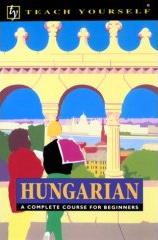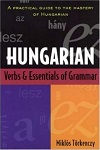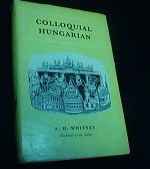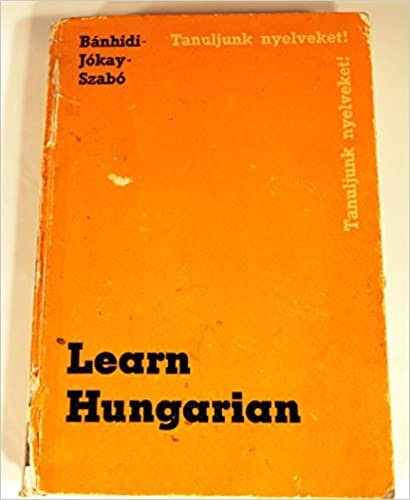Below are reviews, made by Daniel, of Hungarian books. In each case, the book has
been read from cover-to-cover, allowing an objective assessment.
Those written by Hungarians (who have a perfect command of the language but who
might not have correctly gauged the
mind of an Englishman) are not always as helpful as they should be.
I suggest that you read all of the below, and read them in the below order
too. This will give you an excellent grounding the in the language.
ISBN 0-8442-3796-5
 This is a fascinating book, aimed at the complete beginner. It is well-written,
and gives insights into Hungarian life and culture, not just grammar. Each chapter
sets-out its objectives, and begins with a reading. The new concepts of grammar
in the reading are then explained.
This is a fascinating book, aimed at the complete beginner. It is well-written,
and gives insights into Hungarian life and culture, not just grammar. Each chapter
sets-out its objectives, and begins with a reading. The new concepts of grammar
in the reading are then explained.
Its good points are as follows:
- Up to date and modern
- For complete beginners
- Varied style and vast numbers of exercises, with solutions
- After each reading, new words and phrases are detailed in a chronological glossary.
-
It comes with two CDs.
Its downsides are as follows:
- The grammar concepts should be detailed before the reading, not after (I spent ages
searching in previous chapters for concepts that I thought I had missed, whereas
it turned out that the concepts were being introduced in the current chapter).
- The readings do not have translations.
-
The index is next-to-nothing
The original (~1992) version is not as good as the re-edit (~2003) version. The
earlier edition's dictionary is only unidirectional (Hungarian to English).
ISBN 978-0-8442-8350-0
 This book is a complete reference guide, it is NOT designed to be read from scratch
as a course. You should read this cover to cover after you have read the other books.
This book does not really explain concepts, it simply states the rules of grammar
and this gives a couple of examples.
This book is a complete reference guide, it is NOT designed to be read from scratch
as a course. You should read this cover to cover after you have read the other books.
This book does not really explain concepts, it simply states the rules of grammar
and this gives a couple of examples.
It also suffers from being a linguist's book, not a layman's. For example, it explains
the complete rules of the conjunctive-imperative case without explaining
what it means or how to use it until many chapters later; and of talking of "final
consonant gemination".
ISBN 0-415-24256-8
 This is a great beginner's book, but not a novice's book. Its teaching is clear
and the examples are excellent. Despite claiming to be for beginners, it starts
at a little higher level than does Pontifex's book, and goes a little further. As
a complete novice you may, therefore, wish to read Pentifex's book first. For example,
this book goes as far as detailing the hat/het and the at/tat/et/tet grammars. The
grammar does not go as far as
Whitney's 1964 gem.
This is a great beginner's book, but not a novice's book. Its teaching is clear
and the examples are excellent. Despite claiming to be for beginners, it starts
at a little higher level than does Pontifex's book, and goes a little further. As
a complete novice you may, therefore, wish to read Pentifex's book first. For example,
this book goes as far as detailing the hat/het and the at/tat/et/tet grammars. The
grammar does not go as far as
Whitney's 1964 gem.
The book gives complete translations for the readings in the first 3 or 4 chapters,
after which the pace is stepped-up considerably and no translations are given. The
exercises are not as many or as varied in style as Pontifex's.
The quality of the explanation of concepts is second-to-none, but like many other
books this suffers from giving a reading that introduces a new concept before that
concept is explained. I personally don't like this style, as it may leave the read
going around in circles trying to understand (or trying to remember their non-existent
understanding of) the grammar. It also suffers from introducing words that exemplify
a concept but are not particularly useful in everyday (NB. "Colloquial Hungarian")
conversation, such as "parrot".
After the readings a useful, alphabetical glossary is given, but like so many other
books it assumes that the reader has a perfect memory and does not remind him of
words mentioned in previous glossaries. This means that lots of flicking to the
dictionary is necessary for those with imperfect (or otherwise full) minds.
At the end is a good dictionary (but unlike
Whitney's dictionary it is not integrated
with an index), full conjugation tables of the big seven irregular verbs, tables
of examples of irregular (e.g. vowel-dropping) nouns in various cases, etc.
The book has optional audio CDs but I do not own these.
No ISBN. New York / Saphrograph co.
 This is a 1964 book, and not only is its content somewhat out-of-date, but its typograpical
layout is infuriatingly old-fashioned. Placing items in a sequence all on the same
line makes for difficult reading, separating them with carriage returns would make
for much better reading. The use of quote marks is frsutrating.
This is a 1964 book, and not only is its content somewhat out-of-date, but its typograpical
layout is infuriatingly old-fashioned. Placing items in a sequence all on the same
line makes for difficult reading, separating them with carriage returns would make
for much better reading. The use of quote marks is frsutrating.
That said, the teaching is supurb but fast-paced. Each chapter starts with a set
of notes (each numbered, and the author makes extensive use of forward- and back-references
to previous notes, which is great), then a word-list, introducing new words and
phrases, then a reading in Hungarian, and finally exercises.
And example of the quaility of the teaching is that is differentiates between you
(singular) and you (plural) without the need to use those paranthesised suffixes:
it uses thou and ye. Old-fashioned but remarkably effective.
The notes are discrete units of grammar, presenting a single concept per note.
The word list is absolutely wonderful, giving the word, but also its root and some
other examples that make use of this root.
For example, the intended entry is különösen - especially. After this we see, in
parentheses, the following:
külön - apart; különös - singular; kül - outer; külföld - foreign; föld - land.
Also
mozi - cinema is the main entry. After this we see:
mozgó kepek - moving pictures; mozog - move; kép - picture; képvisel - represent;
képes - able; képez - form.
It also gives related words: e.g. after the entry for szerelem - love we see szerelmes
- in love, szerelmes pár - courting couple).
It gives important notes about exeptions: after régi - old, we see öreg - old [man].
When the use of a word is grammatically alien to the Englishman, this this noted:
it is noted after the the word mellett that this is a post-, not preposition. The
readings follow two friends, Mr Szabó and Mr Fehér, during one's visit to see the
other. The reading has a colloquial translation. The exercises are a series of statements
and questions that must be translated into Hungarian.
My complaints are as follows:
- The typesetting, as mentioned.
-
The book is so old-fashioned that it delays the teaching of the second person (you),
and all conversations are held in the third person (he - the polite way to speak
in Hungary). It waits until near the end to teach it. This means that until
chapter 40 one does not know how to address one's best friend!
- The book's subtitle
is "Colloquial Hungarian", and it is true to its word. However I would prefer if
translation of the readings and exercises were NOT translated colloquially, but
literally (with a general translation in parentheses). In my opinion it's more helpful
to the learning of grammar to see the literal translation.
- It also omits to explain why a verbal partical splits from its root.
No ISBN. International Learning Systems.
 This is quite simply the finest book on the Hungarian language.
I first found it in the New York Public Library by chance, and was instantly floored by its detail and thoroughness. I bought it as soon as I could.
The book is written in an easy-to-read way, with comprehensive index of not only words by subject/topics.
It is expensive, but well worth it. If you only buy on book for your studies, buy this one.
This is quite simply the finest book on the Hungarian language.
I first found it in the New York Public Library by chance, and was instantly floored by its detail and thoroughness. I bought it as soon as I could.
The book is written in an easy-to-read way, with comprehensive index of not only words by subject/topics.
It is expensive, but well worth it. If you only buy on book for your studies, buy this one.